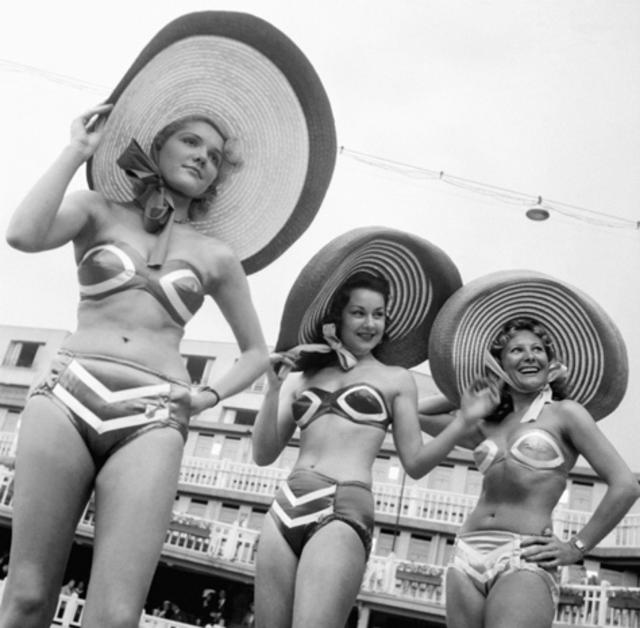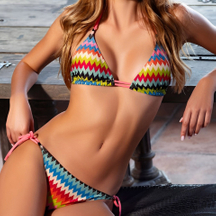Content Menu
● The Origins of Swimwear Manufacturing
>> Ancient Beginnings
>> Industrial Revolution and the Birth of Modern Swimwear
>> Early European Contributions
● The Global Swimwear Manufacturing Landscape
>> China: The Manufacturing Powerhouse
>> Other Key Manufacturing Countries
● Key Countries in Swimwear Manufacturing
>> 1. China
>> 2. Brazil
>> 3. Italy
>> 4. Portugal
>> 5. Thailand
● Swimwear Manufacturing: From Design to Delivery
>> Design and Prototyping
>> Material Selection
>> Production and Quality Control
>> Logistics and Distribution
● The Evolution of Swimwear Styles
>> Historical Milestones
● The Role of OEM Services in Swimwear Manufacturing
>> What is OEM?
>> Benefits of Working with a Chinese OEM Factory
● The Impact of Technology on Swimwear Manufacturing
● Current Trends in Swimwear Manufacturing
● Conclusion
● Frequently Asked Questions
● Citations:
What Country Originally Manufactures Swimwear: A Deep Dive into Swimwear Production and OEM Services
Swimwear has evolved from ancient times to today's high-tech, stylish garments, and the question "what country originally manufactures swimwear" is both historical and contemporary. For global swimwear brands, understanding the origins and current state of swimwear manufacturing is essential for sourcing, quality assurance, and market positioning. As a leading Chinese swimwear production and OEM (Original Equipment Manufacturer) factory, we offer insights into the industry, from the roots of swimwear production to modern global supply chains.

The Origins of Swimwear Manufacturing
Ancient Beginnings
The earliest forms of swimwear were not manufactured in factories but rather crafted from available materials. In classical antiquity, swimming was generally done in the nude or with minimal clothing, such as loincloths or simple tunics[1][4]. The idea of a "swimsuit" as a manufactured garment did not exist. However, the concept of covering the body for swimming or bathing emerged in various cultures, often using locally available textiles or animal hides[4].
Industrial Revolution and the Birth of Modern Swimwear
The Industrial Revolution brought significant changes to textile production, making it possible to mass-produce clothing, including swimwear. The question "what country originally manufactures swimwear" in the modern sense points to the late 19th and early 20th centuries. During this period, swimwear became a distinct garment, with early manufacturers in Europe and North America leading the way.
In the United States, the Jantzen Knitting Mills, based in Portland, Oregon, played a pivotal role in swimwear manufacturing. Carl Jantzen and his partners started knitting wool suits for rowing clubs, which later became popular for swimming[6]. The term "swimsuit" was officially coined by Jantzen in 1915, marking a significant milestone in the industry[6]. By the 1920s, Jantzen's swimwear was widely advertised and recognized globally, and the company became synonymous with high-quality swimwear production[6].
Early European Contributions
While American manufacturers like Jantzen were leading the way, Europe also contributed to the evolution of swimwear manufacturing. In the early 20th century, European designers and manufacturers began experimenting with new materials and designs, leading to innovations such as the introduction of the bikini in 1946 by French designers Jacques Heim and Louis Réard[2][5]. However, the question "what country originally manufactures swimwear" in the modern sense still largely points to the United States as the birthplace of mass-produced swimwear.

The Global Swimwear Manufacturing Landscape
China: The Manufacturing Powerhouse
Today, when considering "what country originally manufactures swimwear", the focus often shifts to global supply chains and manufacturing hubs. China has become the world's leading swimwear manufacturer, offering large-scale production, advanced infrastructure, and established supply chains[3]. The country's textile industry is highly developed, providing easy access to a wide range of materials and components, which streamlines the production process and allows for both large and small orders[3].
For international brands, working with a Chinese swimwear OEM factory means benefiting from cost efficiency, scalability, and flexibility. China's ability to handle complex orders and adapt to changing market trends makes it a preferred choice for many global swimwear brands, wholesalers, and manufacturers[3].
Other Key Manufacturing Countries
While China dominates the industry, other countries also play significant roles in swimwear manufacturing. Vietnam, Thailand, the United States, Italy, Morocco, Turkey, and Portugal are important players, each offering unique advantages[3].
- Vietnam: Known for competitive labor costs and a skilled workforce, Vietnam is a popular alternative to China for swimwear production.
- Thailand: With a well-established textile sector, Thailand offers experienced professionals and logistical advantages for brands targeting Asian markets[3].
- United States: Domestic production in the U.S. provides control and flexibility, but higher labor costs and limited capacity can be drawbacks[3].
- Italy: Renowned for luxury and craftsmanship, Italian manufacturers are preferred for premium swimwear[3].
- Morocco: Offers cost-effective production and proximity to European markets, making it a strategic choice for nearshoring[3].
- Turkey: Bridges Europe and Asia, offering high-quality production and fast turnaround times[3].
- Portugal: Focuses on sustainability and ethical production, appealing to eco-conscious brands[3].
Key Countries in Swimwear Manufacturing
1. China
Today, China is one of the largest manufacturers of swimwear globally. The country has a well-established textile industry that allows for mass production of swimwear at competitive prices. Many international brands outsource their production to Chinese factories due to the availability of skilled labor and advanced manufacturing technologies.

2. Brazil
Brazil is renowned for its vibrant swimwear designs, particularly bikinis. The country's beach culture has influenced swimwear styles worldwide. Brazilian manufacturers often focus on high-quality materials and unique designs that cater to both local and international markets.
3. Italy
Italy has a long-standing reputation for luxury fashion, including swimwear. Italian brands are known for their high-quality fabrics and stylish designs. The country's fashion houses often set trends that influence global swimwear styles.
4. Portugal
Portugal has emerged as a significant player in swimwear manufacturing, particularly for European brands. The country is known for its craftsmanship and sustainable production practices, making it an attractive option for brands looking to produce eco-friendly swimwear.
5. Thailand
Thailand is another key player in the swimwear manufacturing industry. The country offers a combination of affordable labor and skilled artisans, making it a popular choice for brands looking to produce swimwear at a lower cost without compromising quality.
Swimwear Manufacturing: From Design to Delivery
Design and Prototyping
The process of swimwear manufacturing begins with design. Brand owners, designers, and OEM partners collaborate to create swimwear that meets market demands and brand identity. Modern swimwear is designed using advanced software, allowing for precise pattern-making and virtual prototyping.
Material Selection
The choice of materials is crucial in swimwear manufacturing. Early swimwear was made from wool, which was heavy and lost its shape when wet[2][6]. Today, synthetic fabrics such as nylon, polyester, and spandex are used for their durability, stretch, and quick-drying properties. Innovations like Lastex yarn, introduced in the 1930s, revolutionized swimwear by providing stretch and shape retention[2][6].
Production and Quality Control
Once the design and materials are finalized, production begins. Large-scale OEM factories in China and other manufacturing hubs use advanced machinery and skilled labor to produce swimwear efficiently. Quality control is a critical step, ensuring that each garment meets international standards and brand specifications.
Logistics and Distribution
After production, swimwear is packaged and shipped to brand owners, wholesalers, or retailers worldwide. China's well-developed logistics network enables fast and reliable delivery to global markets[3].
The Evolution of Swimwear Styles
Swimwear styles have evolved dramatically over the years, influenced by cultural shifts, technological advancements, and fashion trends.
Historical Milestones
- Ancient Times: Early swimwear was often non-existent, with many cultures practicing swimming in the nude.
- 19th Century: The introduction of woolen swimsuits marked the beginning of specialized swimwear.
- 1920s: The one-piece swimsuit gained popularity, reflecting changing attitudes towards women's fashion.
- 1940s: The bikini was introduced, revolutionizing swimwear and challenging societal norms.
- 1970s and 1980s: The introduction of synthetic materials like Lycra and Spandex allowed for more form-fitting and comfortable swimwear.
The Role of OEM Services in Swimwear Manufacturing
What is OEM?
OEM stands for Original Equipment Manufacturer. In the context of swimwear, OEM factories produce swimwear according to the specifications of brand owners, who then sell the products under their own brand names. This allows brands to focus on design, marketing, and sales, while relying on OEM partners for manufacturing expertise.
Benefits of Working with a Chinese OEM Factory
- Cost Efficiency: Lower production costs compared to many other countries[3].
- Scalability: Ability to handle both small and large orders[3].
- Quality Assurance: Advanced quality control systems ensure high standards.
- Flexibility: Quick adaptation to new designs and market trends[3].
- Comprehensive Services: From design support to logistics, OEM factories offer end-to-end solutions.
The Impact of Technology on Swimwear Manufacturing
Advancements in textile technology have significantly impacted swimwear manufacturing. The introduction of synthetic materials has allowed for the creation of swimwear that is not only more comfortable but also more durable and quick-drying. Brands now utilize high-tech fabrics that enhance performance for competitive swimmers, such as those used in Olympic competitions.
Current Trends in Swimwear Manufacturing
Today, the swimwear industry is witnessing several trends that reflect consumer preferences and environmental concerns:
- Sustainability: Many brands are focusing on eco-friendly materials and production processes to reduce their environmental impact.
- Inclusivity: There is a growing demand for swimwear that caters to diverse body types and sizes, leading to more inclusive sizing options.
- Fashion-Forward Designs: Swimwear is increasingly seen as a fashion statement, with bold colors, patterns, and styles that reflect current fashion trends.
Conclusion
The history of swimwear manufacturing is a fascinating journey that reflects cultural shifts, technological advancements, and changing fashion trends. From its origins in ancient civilizations to the modern-day global industry, swimwear continues to evolve, influenced by various countries and cultures. Today, countries like China, Brazil, Italy, Portugal, and Thailand play significant roles in the manufacturing of swimwear, each contributing unique styles and innovations to the market.
Frequently Asked Questions
Q1: What country originally manufactures swimwear in the modern sense?
A1: The United States, with companies like Jantzen Knitting Mills, is credited with the mass production of swimwear in the early 20th century. However, today, China is the leading manufacturer of swimwear globally[3][6].
Q2: How has swimwear manufacturing evolved over time?
A2: Swimwear manufacturing has evolved from handmade garments to mass-produced, high-tech apparel. Innovations in materials and design have made swimwear more functional, comfortable, and stylish[1][2][6].
Q3: What are the advantages of using a Chinese OEM factory for swimwear production?
A3: Chinese OEM factories offer cost efficiency, scalability, quality assurance, flexibility, and comprehensive services, making them a preferred choice for global brands[3].
Q4: What materials are used in modern swimwear manufacturing?
A4: Modern swimwear is typically made from synthetic fabrics such as nylon, polyester, and spandex, which provide durability, stretch, and quick-drying properties[2][6].
Q5: How do OEM services benefit swimwear brands?
A5: OEM services allow brands to focus on design and marketing while leveraging the manufacturing expertise and resources of OEM partners, resulting in faster time-to-market and lower costs[3].
Citations:
[1] https://en.wikipedia.org/wiki/History_of_swimwear
[2] https://fashionhistory.fitnyc.edu/a-history-of-womens-swimwear/
[3] https://deepwear.info/blog/mens-swimwear-manufacturing-strategic-insights-for-global-brands/
[4] https://www.loverskeyadventures.com/history-of-swimwear/
[5] https://www.swimmingpool.com/blog/swimsuits-throughout-history/
[6] https://www.ephemerasociety.org/the-history-of-swimwear/
[7] https://artsandculture.google.com/story/the-radical-history-of-the-swimsuit/CwWRYuCmuuxYLg
[8] https://vintagefashionguild.org/blog/swimwear-history/
[9] https://scmuseum.org/learn/deeper-dive-series/bloomers-bikinis-brief-history-bathing-suit
[10] https://www.fortunebusinessinsights.com/swimwear-market-103877
[11] https://www.instagram.com/swimwearmanufacturers/
[12] https://swimwearmanufacturermiami.com/photo-gallery
[13] https://swimwearmanufacturercalifornia.com/swimwear-photo-gallery
[14] https://www.leftyproductionco.com/swimwear-and-swimsuits-wear
[15] https://www.gettyimages.com/photos/swimwear-production-at-malia-mills-manufacturing-facility
[16] https://activeqstom.com
[17] https://swimwearmanufacturernewyork.com
[18] https://www.youtube.com/watch?v=gUHGfSKiW88
[19] https://www.youtube.com/watch?v=gaBTwPJuJ5s
[20] https://deepwear.info/blog/swimwear-manufacturing/




































